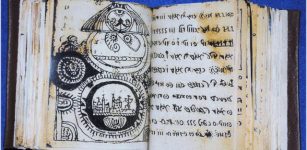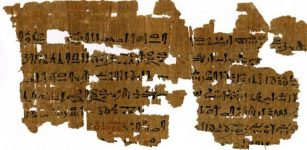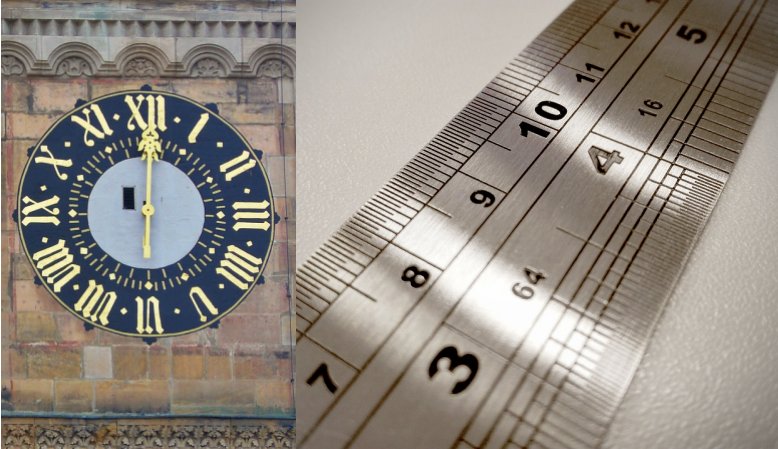Why Did We Abandon Roman Numerals?
Conny Waters - AncientPages.com - It’s often said that we’ve abandoned Roman numerals, which is not entirely true. We can still find Roman numerals on clock’s, monuments, in books, personal titles and other places. We just don’t use the Roman numerals often because we switched to the Arabic numeric system.
Credit: Public Domain
Romans numerals are a numerical system composed of seven Latin letters. Ancient Romans adapted the numerical systems from Etruscan numerals.
The symbols are I, V, X, L, C, D, and M, standing respectively for 1, 5, 10, 50, 100, 500, and 1,000 in the Hindu-Arabic numeral system.
Ancient Romans and Europeans used Roman numerals for a long time, but it’s was not a practical numerical system. For example, Roman Numerals do not have a zero (0). Arabic numbers have ten digits (from 0-9) and they give us the opportunity to produce very large numbers.
See also:
Why Is The Three Golden Balls Symbol For A Pawn Shop Connected To The Medici Family?
Torquetum: Sophisticated Medieval Astronomical Instrument
Nomenclator: Ancient Living-Human Calendar And Address Book
Merkhet – An Ancient Egyptian Timekeeping Instrument
Leonardo Fibonacci (c. 1170 – c. 1250), an Italian mathematician who is considered the most talented Western mathematician of the Middle Ages introduced the Hindu–Arabic numeral system in the Western World primarily through his composition in 1202 of Liber Abaci (Book of Calculation).
While visiting North Africa, Fibonacci learned the Hindu–Arabic numeral system and he quickly understood this system was better suitable for mathematics. It should be noted that “the Arabs did not immediately adopt the Hindu zero, because it resembled their 5; they used the superscript dot as serving their purposes fairly well.” (The Hindu-Arabic numerals- David Eugene Smith and Louis Charles Karpinski)
Through his book he managed to convince many European mathematicians to abandon Roman numerals and start using the Hindu-Arabic system instead.
Calculating-Table by Gregor Reisch: Margarita Philosophica, 1503. The woodcut shows Arithmetica instructing an algorist and an abacist (inaccurately represented as Boethius and Pythagoras). There was keen competition between the two from the introduction of the Algebra into Europe in the 12th century until its triumph in the 16th. Credit: Public Domain
To keep track of their sales and expenses, ancient European merchants relied on counting beads and Roman numerals were only used to document the results. Even though the Hindu Arabic system offered many advantages, for some reason salesmen were rather reluctant towards it, and it took time before the new numerical system became accepted.
In The Introduction of 'Arabic' Numerals in European Accounting, John W. Durham explained that “the preference for Roman numerals continued among bookkeepers until the sixteenth century, hundreds of years after the introduction of Arabic numbers. The preferences is well-known, but the causes are not.”
In time people understood that by switching to the Hindu–Arabic numeral system it was possible to solve complicated mathematical problems and counting became much easier. The new system permitted mathematical operations to be made on arbitrarily large numbers.
Written by Conny Waters – AncientPages.com Staff Writer
Copyright © AncientPages.com All rights reserved. This material may not be published, broadcast, rewritten or redistributed in whole or part without the express written permission of AncientPages.com
Expand for referencesLouis Charles Karpinski and David Eugene Smith - The Hindu-Arabic Numerals
Durham, John W. "THE INTRODUCTION OF "ARABIC" NUMERALS IN EUROPEAN ACCOUNTING." The Accounting Historians Journal 19, no. 2 (1992): 25-55. http://www.jstor.org/stable/40698081.
More From Ancient Pages
-
 Prehistoric Hi-Tech Nanospirals Barely Visible To The Naked Eye: Still Remain An Unsolved Mystery
Ancient Technology | Mar 4, 2014
Prehistoric Hi-Tech Nanospirals Barely Visible To The Naked Eye: Still Remain An Unsolved Mystery
Ancient Technology | Mar 4, 2014 -
 Nebuchadnezzar II – Greatest Ruler Of Ancient Babylonia And Conqueror Of Judah
Featured Stories | Jan 28, 2019
Nebuchadnezzar II – Greatest Ruler Of Ancient Babylonia And Conqueror Of Judah
Featured Stories | Jan 28, 2019 -
 A Seal Impression Dated To Persian Period Discovered In The City Of David
Archaeology | Jul 3, 2020
A Seal Impression Dated To Persian Period Discovered In The City Of David
Archaeology | Jul 3, 2020 -
 Modern Pesticide Accelerates Corrosion Of Ancient Roman Bowl
Archaeology | Oct 6, 2022
Modern Pesticide Accelerates Corrosion Of Ancient Roman Bowl
Archaeology | Oct 6, 2022 -
 Ancient Native American Stories Of Great Floods In Tennessee Confirmed By Scientists – 1867 Flood Was Not The Worst One
News | Aug 26, 2020
Ancient Native American Stories Of Great Floods In Tennessee Confirmed By Scientists – 1867 Flood Was Not The Worst One
News | Aug 26, 2020 -
 Artificial Intelligence Recreates Pompeii’s Ruined Ancient Masterpieces
Archaeology | Jul 8, 2023
Artificial Intelligence Recreates Pompeii’s Ruined Ancient Masterpieces
Archaeology | Jul 8, 2023 -
 Sogdian Temple Of Jartepa II On Caravan Road Of The Silk Road
News | Sep 3, 2020
Sogdian Temple Of Jartepa II On Caravan Road Of The Silk Road
News | Sep 3, 2020 -
 Ancient City Of Laodicea With One Of ‘Seven Churches Of Asia’ Founded By The King Antiochus II
Featured Stories | Jul 26, 2021
Ancient City Of Laodicea With One Of ‘Seven Churches Of Asia’ Founded By The King Antiochus II
Featured Stories | Jul 26, 2021 -
 Legendary Lost Island Of Gold Of The Mysteriously Vanished Srivijaya Civilization Found Underwater
Archaeology | Oct 25, 2021
Legendary Lost Island Of Gold Of The Mysteriously Vanished Srivijaya Civilization Found Underwater
Archaeology | Oct 25, 2021 -
 Could Shipworms Be Destroying The Wreck Of Captain Cook’s Endeavour?
Archaeology | Aug 18, 2022
Could Shipworms Be Destroying The Wreck Of Captain Cook’s Endeavour?
Archaeology | Aug 18, 2022 -
 Rohonczi Codex Still Undeciphered – Is It The Most Secret Book Written In A Code?
Artifacts | May 30, 2014
Rohonczi Codex Still Undeciphered – Is It The Most Secret Book Written In A Code?
Artifacts | May 30, 2014 -
 Catherine De Medici – Queen Of France Supported Nostradamus, Was Suspected Of Poisoning And Blamed For Horrible Massacre
Featured Stories | Dec 17, 2018
Catherine De Medici – Queen Of France Supported Nostradamus, Was Suspected Of Poisoning And Blamed For Horrible Massacre
Featured Stories | Dec 17, 2018 -
 Mysterious Book That ‘Killed’ – Are Written Or Spoken Words Powerful Enough To Take Control Over Our Actions?
Featured Stories | Nov 21, 2022
Mysterious Book That ‘Killed’ – Are Written Or Spoken Words Powerful Enough To Take Control Over Our Actions?
Featured Stories | Nov 21, 2022 -
 What Did Ancient Mesoamerican Civilizations Know About Unusual Powers Of The Mind?
Featured Stories | Feb 13, 2020
What Did Ancient Mesoamerican Civilizations Know About Unusual Powers Of The Mind?
Featured Stories | Feb 13, 2020 -
 Mystery Of The Boxgrave Humans – Fossils In The UK Reveal How Ancient Europeans Were Connected
Archaeology | Nov 15, 2022
Mystery Of The Boxgrave Humans – Fossils In The UK Reveal How Ancient Europeans Were Connected
Archaeology | Nov 15, 2022 -
 Remarkably Well-Preserved Thermopolium With Frescoes, Food, And Jars Discovered In Pompeii
Archaeology | Dec 28, 2020
Remarkably Well-Preserved Thermopolium With Frescoes, Food, And Jars Discovered In Pompeii
Archaeology | Dec 28, 2020 -
 Knowledge Of Ancient Medicine Hidden In Undeciphered Egyptian Manuscripts
Archaeology | Aug 16, 2018
Knowledge Of Ancient Medicine Hidden In Undeciphered Egyptian Manuscripts
Archaeology | Aug 16, 2018 -
 Mysterious Chachapoyas ‘Warriors Of The Clouds’ And Their Impressive Structures
Civilizations | Nov 4, 2020
Mysterious Chachapoyas ‘Warriors Of The Clouds’ And Their Impressive Structures
Civilizations | Nov 4, 2020 -
 Researchers reconstructed face of oldest pharaonic mummy ‘Kent’
News | Sep 1, 2015
Researchers reconstructed face of oldest pharaonic mummy ‘Kent’
News | Sep 1, 2015 -
 Ruins Of 2,300-Year-Old City Of Jiaohe On The Silk Road
Civilizations | Aug 6, 2023
Ruins Of 2,300-Year-Old City Of Jiaohe On The Silk Road
Civilizations | Aug 6, 2023


